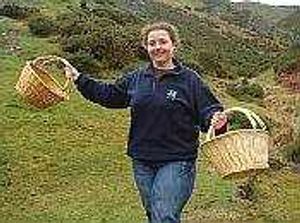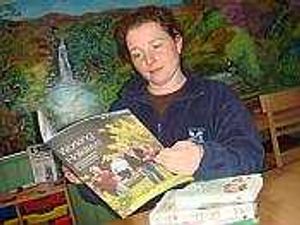Time to open Mother Nature's larder
Shropshire offers rich pickings when it comes to foraging for free food - and one county woman is an expert. Shropshire offers rich pickings when it comes to foraging for free food - and one county woman is an expert. It makes the head spin to think how much Popeye spent on spinach. But now it turns out that everyone's favourite sailor man, who'd wolf down his greens to fight Bluto and win the heart of the lovely Olive Oyl, missed a trick. He'd have been better off necking nettles like the rest of us and growing his muscles for free. "Nettles are as good for you as spinach," says Shropshire forager and National Trust volunteer Jane Allsop, "and they are a bit cheaper." Indeed, they won't sting you for cash. And they'll soon be in abundant supply. For the forager, the arrival of springtime in Shropshire is like the dinner bell going off at Mother Nature's larder. And Jane is the woman perfectly placed to show us how to cash in. * Find out what our writer Ben Bentley managed to track down in tonight's Shropshire Star

 Shropshire offers rich pickings when it comes to foraging for free food - and one county woman is an expert. Ben Bentley reports.
Shropshire offers rich pickings when it comes to foraging for free food - and one county woman is an expert. Ben Bentley reports.
It makes the head spin to think how much Popeye spent on spinach. But now it turns out that everyone's favourite sailor man, who'd wolf down his greens to fight Bluto and win the heart of the lovely Olive Oyl, missed a trick.
He'd have been better off necking nettles like the rest of us and growing his muscles for free.
"Nettles are as good for you as spinach," says Shropshire forager and National Trust volunteer Jane Allsop, "and they are a bit cheaper."
Indeed, they won't sting you for cash. And they'll soon be in abundant supply.
More recently our hunter-gatherer instincts have been reined in and restricted to controlled forages in the ready-meal aisle of big supermarkets.
For the forager, the arrival of springtime is like the dinner bell going off at Mother Nature's larder.
Weeds, wild crops, fruit and fungi - both edible and nutritious - leap to life in fields, hedgerows and woods. And that means a free lunch. In these belt-tightening days, it's too good an opportunity to miss.
Novices are warned to be careful in choosing locations for foraging, and thankfully help is at hand. Jane is leading a new "foraging school" as part of one of the first ever working holidays to be held at National Trust venues in the UK, and from the Attingham Park base in Shrewsbury she'll be teaching rookies how to become hunter-gatherers and make the most of the wild ingredients available without a trip to the supermarket.
Weeds, more commonly viewed as enemies of the formal garden, are now our best friends and the working holidays will use only local food, wherever possible foraged.
Having grown up in the Clun Valley, Jane is a lifelong forager and she says rural Shropshire is a bounty of wild food - wimberries, blackberries, nuts, seeds and, yes, nettles to name just some.

"Historically we used to use wild ingredients.
"Nettles are full of goodness - there's a lot of trace elements such as potassium and magnesium and plenty of protein and vitamins. They grow fast in April and May. But I think they are best early, before they flower."
Wild garlic is one of Jane's favourite foraged foods and soon the woodland floor will be furnished with a carpet of it.
"It's lovely as flowers for salad and the leaves are great as a garnish or in soup. Plus, it's better for food miles than importing it from Spain. Try wild venison with garlic and mash."
Dandelions are great for salad and we are spoilt for nuts in Shropshire, says Jane. Hazelnuts, cobnuts, walnuts. Nut roast is rarely a problem for Salopians.
And we're spoilt for wimberries on higher ground.
"Wimberries are our equivalent of blueberries and they make great jams, or you can use them in a crumble with apple," she adds.
"And they're fantastic in muffins."
A wander around unearths damsons, a local variety of which is called bullace. Jane looks at the raw ingredients and sees finished products: wild fruit jams, damsons with cream.
Elderflowers, says Jane, can be picked to make fritters and puddings - just dip in batter, fry to a crisp and Bob's your uncle.
She says: "They look a bit clumpy but there's a very subtle flavour of elderflowers - you treat them like pancakes. Or you can add lemon and make a cordial.
"It's rich in vitamin C and it's good for the back of the throat - keep a bottle of it as a stand-by because a lot of plants have medicinal qualities.
"It's like nettles - good for rheumatism. Animals self-medicate using plants, and you see old dogs chewing them and it's as if they know. It's no surprise that homeopathy has picked up on this and made it into a science."
The list of wild ingredients that can be foraged for free goes on: fungi, chickweed, blackberries, elderberries, sorrel.
"We have lost a lot of contact with wild food, but all the celebrity chefs are on to it and it's a bit sad really that it's becoming trendy - because often they don't say go foraging only in certain places where it's not going to harm wildlife and other plants," says Jane, who warns people they can't forage on owned land without permission. The working holidays will forage on National Trust land.
Several generations have passed, which have not relied upon the wild food under their noses, but historically people have always picked from land.
Says Jane: "We used to use wild food out of necessity. People were poor and they used the things around them. They didn't have a supermarket. But other cultures have not lost it - you get half of Spain going out on a Sunday looking for ingredients."
Woods are not the only happy hunting ground for foragers either. We could forage our own wild gardens.
Says Jane: "For a lot of people it could be a garden full of weeds, but it's not. A lot of it is useable as ingredients.
Jane admits that most people don't have the time or inclination to live solely off the land, but as complementary ingredients, foraged foods knocked spots off their mass produced rivals.
"It's hard to live on just wild food and live a normal life - you need a lot of time. It would become a full-time job and it's not realistic for anybody. You would have to fish, trap, snare and prepare food in season to get you through the winter.
"But it's hugely satisfying to go on a nice walk, pick a few seasonal things and get back home that evening and have it on a plate."
And this year we are having it on a plate.
As we head out into the Shropshire Hills at Carding Mill Valley with a couple of wicker baskets in hand, Jane adds: "The hills are full of food for people who know where to look."




